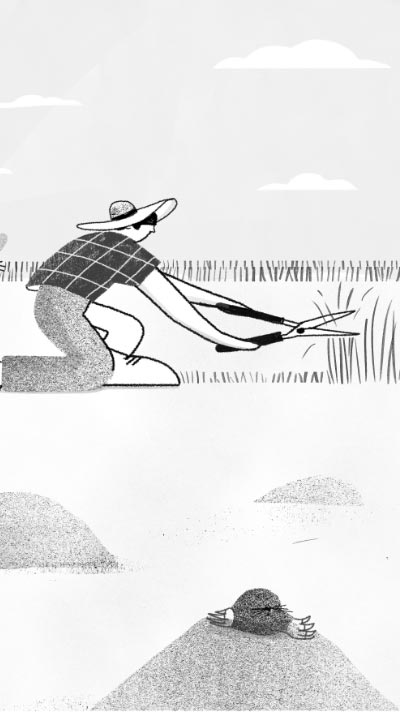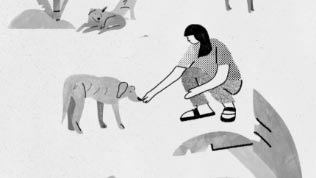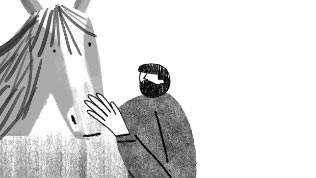Heaven is feral
by Melanie Challenger
Looking for the wild, we can see a better world, animated by the bodies, minds and agency of other animals.
Children aren't born doubting the lives of other animals. They must be taught to doubt.
What I mean by 'doubt' is a lack of conviction that other species are the subjects of a rich and meaningful life on Earth. While this doubt remains in our minds, the species living alongside us will always be vulnerable to unnecessary harm at our hands.
I grew up in a suburban world in the shadow of the environmental crisis. As a baby, my mother and father took me home from the hospital to a little terraced house near Oxford; later, we moved to a housing estate in Berkshire. The houses were separated by compressed corridors of wildness: a row of conifers on one side, a tangle of under-weeded flower beds on the other.
As a child, it seemed to me that adults thought heaven was human. Yet I was more curious about that feral world I glimpsed between the houses. These spaces of wildness drew me. Like vents into another world, something feral was struggling through them. Hedgehogs and toads, those musty familiars of buried woodlands, materialised from the darkness. Slow worms, like Roman torques quickened by daylight, lived in the abandoned piles of cut grass. Occasionally a fox would flare through the trees and be gone.
The aesthetic of feral is often an untidy one. It can also be a nuisance. House martins that nest in the eaves of people's houses spill their waste on the patio below. Molehills muck up a lawn. Rabbits dig their homes in our flowerbeds. Weeds - whatever they are - rebel against the gardener's design. Many of the adults around me in the neighbourhood were hellbent on restoring order. In the town where I lived, there were molecatchers and rabbit catchers, pest controllers and exterminators. People used rat poison, Roundup weed killer. They trimmed their hedges and mowed their lawns - and so the feral began to shrink. And this was mirrored on a global scale.
As a teenager, I spent hours reading my encyclopaedia of animals, in which species were listed according to whether they were endangered or at risk of extinction. In the pages of that book, I discovered that the decisions of my own species were causing irrecoverable losses to life on our planet. Our unashamed killing and destruction shocked me. For me, as for many children, heaven was other animals. But I began to realise that the wild creatures I encountered at the feral edges of the town not only lived on leftovers but were themselves leftovers of a former abundance. In my dreams, I would follow them into a technicolour otherworld, where life was free and plentiful.
Many young people today, who have only learned of biodiversity loss through public figures like Greta Thunberg - in other words, through members of their own generation - could be forgiven for thinking that these events are new. The reality is more frightening. Every generation for at least a century has understood that human activities, greatly magnified since the onset of industrialisation, have been damaging and polluting the living world. Many have protested. There has been a century-long chorus of voices calling on humanity to initiate a better relationship with the rest of nature.
What we often forget is that the biodiversity crisis is also a moral crisis. The state of the planet is an expression of our values. In modern civilisations, especially in post-industrial nations, it is common to view the Earth and all its life-forms as only having significance in terms of usefulness to us. At the same time, we've justified everything we've done in the name of humanity. Put simply, our world has been made by the moral choices of an animal that believes only its own kind has moral status. Put even more simply: the world is rigged in our favour.
It is interesting that the RSPCA was founded around the same time that the first photographs appeared. Around 200 years ago, we invented a method to capture a memory. Our own memories are notoriously unreliable. Our perceptual world is one in which bias and impermanence can be an advantage. Photography evolved to capture a moment with those we love or a moment from history we might want to remember with real clarity. But photographs also forced us to see things we might rather forget or hide from sight.
It was a photograph of the earthrise that launched the environmental movement of the 1970s; a photograph of a young girl on fire in a village in Vietnam that forever damaged the American exceptionalism used to justify that war. It was frighteningly graphic photography from the Second World War that confronted us with the realities of the Holocaust.
Photographs have also played an important role in how we've viewed our relationship to other species. The Mattingley photos of the plumage trade were essential to the appearance of the Plumage Bill in 1914, banning the trade in exotic birds. Photographs of animal cruelty have assisted advocacy for better protections for species used in industry. The recent photographs of animals in captivity by Canadian journalist Jo-Anne McArthur may come to transform how we look at farm animals
It was a photograph that changed the way I saw our world. I was around nine years old when a leaflet dropped through the letterbox of my home. It showed a rabbit enduring testing for cosmetics. I remember staring at it in confusion. Why would we do something like that? Why do something so unpleasant to another sentient being for something as trivial as a face cream? What this photograph showed me was the stark partiality of our moral convictions.
When confronted by a society that seems to see other animals as little more than utensils with a face, children are mystified. Surely only a strange kind of insensibility could account for such behaviour? When children query such actions and hear adults respond with blithe confidence, they are even more perplexed. Children are told that the world of this rabbit is somehow less than ours. Rabbits can't write poetry or engineer a computer. Rabbits can't think symbolically or morally. Rabbits can't speak. They have smaller brains and narrower lives and, as such, they have no real significance.
And children will respond, 'But a rabbit is its own person. A rabbit is full of rabbitness. It's not an impoverished human'.
And an adult will answer, 'Yes, but there's more humanness than there is rabbitness. And humanness is therefore richer and more important. Rabbits have no sense of right or wrong. Rabbits aren't political animals. Rabbits can't think in the abstract. Rabbits can't write their rights into law and, in any case, there's no law in nature, only nature red in tooth and claw'.
Not all human cultures have had such doubts. Hunter-gatherer societies - in other words, societies that live entangled with the wild - have looked out on a world animated by the minds and spirits of other creatures. Commonly, these cultures worship rather than trivialise the lives of other species. This doesn't mean that animals aren't harmed, but the harm isn't justified by the idea that other animals are lesser beings than humans.
Such relationships rarely survive the shift to modern agriculture and industry. Echoes of them survive in classical Greece, in Aristotle's belief in animal, vegetal and human souls; and in early eastern spiritualities, where energies flow across the living world. But the world view that has come to dominate is staggeringly hierarchical, according to which life is a chain of beings with humans at the top. Only we have souls. Only we ascend to heaven. Only we are animated by lives of true value. This is a devastating perspective on the biology of other beings, from tigers to sheep to albatrosses to stag beetles.
Often, people place the blame for this shift on events like the rise of Christianity, or on individual thinkers like Descartes, who claimed other animals were little more than machines made of flesh. It's certainly true that some influential thinkers reinforced this belief in a hierarchy by arguing that our minds are soul-like and account for and justify our superior value. Philosophers have been making bold claims of this kind for centuries.
But that's only part of the story. Whether we start from a secular or religious point of view, many of us have been convinced that humans have full moral status simply for being human. When asked to justify this belief, we default to ideas about a special essence that only humans possess. The soul, dignity, or rationality are three of the commonest kinds of unique essences we still call upon to carve our moral world in two.
There is necessity at work in all this: these modern tendencies to doubt other animals aren't rational or logical or inevitable. They are inculcated in us for reasons. And these reasons aren't particularly edifying. The main reason a moral division exists is to justify our own natural urges to exploit other species and cause them harm. We are cursed (or blessed) with being an animal that can see the harm it does. For a moral predator like us, we need compelling excuses to do to a sentient being what we'd find intolerable if done to us and so we default to our imaginations to come up with excuses to continue inflicting pain or death. The widespread human-held doubt about the value of other life-forms saves us from a more complicated reality. It is an invention of expediency. It's understandable. But that doesn't make it right.
Today, we have welfare standards for our treatment of other animals that can be traced back to English philosopher Jeremy Bentham's game-changing challenge: `The question is not, Can they reason? nor, Can they talk? but, Can they suffer?'
Since Richard Martin, William Wilberforce and Reverend Broome founded the Society for the Prevention of Cruelty to Animals (SPCA) - later to become the RSPCA when Queen Victoria assigned it royal status - not long after Bentham published his words, we've come a long way in expanding our fellow feeling to the different beings on this planet. It's now widely acknowledged that other animals can and do suffer at our hands and that moral duties follow from this. Accordingly, we've placed limits on the worst of our cruelties.
Now we are also beginning to recognise sentience - the ability to feel and experience one's life - in law, though the full consequences of this for other species are yet to be seen.
But we must recognise that a better relationship with the other animals on Earth will never truly emerge while we continue to see everything that isn't human as somehow trivial. Recognition of neither suffering nor sentience will change our actions if we still doubt the true value of the life in question. Our compassion will always be held in check while that doubt remains.
Perhaps, instead, we might take a lesson from our children. Most children come into this world in cautious fellowship with the rest of the life around them. They respect and recognise the beauty, strangeness and the particular qualities of other species instinctively, even of those they fear. In other words, children respect other animals on their own terms. But that respect can be quickly eroded by the messaging of both adults and our society. And, in today's modern world, most children will abandon the feral heaven and unlearn their love. Our only hope for real change will come when children stop listening to us.

Melanie Challenger
Melanie Challenger works as a researcher and broadcaster on the history of humanity and the natural world and ethics. Her books include On extinction: How we became estranged from nature and How to be animal: A new history of what it means to be human. She hosts the podcast, Enter the psychosphere, on diverse intelligences.



